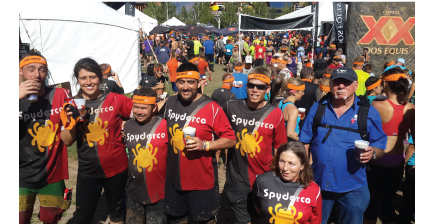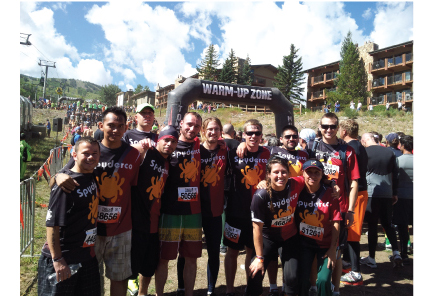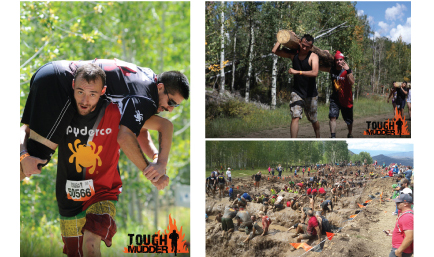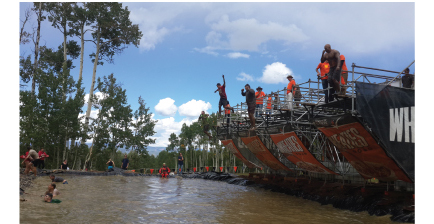
|
|

|
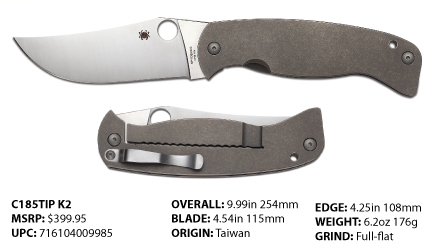
Farid Mehr is a British custom knifemaker who is best known for his hollow-handled fixed-blade survival knives and heavy-duty, hard-use folding knives. A full-time maker, he also crafts custom-made leather and Kydex® sheaths and makes a variety of other custom knives to meet his customers’ needs and interests. Strength is the most prized quality of most of Farid’s knife designs, so his folders tend to be large and boast stainless steel or titanium handle scales and Reeve Integral Locks (R.I.L.). He also has a penchant for using exotic blade steels with reputations for edge holding and toughness. One of his most popular models is his K2 folder, which is slightly smaller and lighter than many of his other designs without sacrificing the key qualities that make his knives unique. It was therefore the ideal choice for his first collaboration with Spyderco. The K2 is a generously sized folding knife designed to withstand the rigors of serious cutting chores. Just shy of 10 inches (254mm) overall, it features a 4.53-inch (115mm) blade ground from CPM® 10V®—the first high-vanadium tool steel made using Crucible® steel’s Powder Metallurgy process. CPM 10V’s toughness and machining characteristics are comparable to D2 and M2, but it’s impressive 9.75% vanadium content gives it extreme wear resistance. In a knife blade, this translates to superior edge retention—a highly desirable quality for a hard-use folder. To balance the strength of its broad Bowie-style blade, the K2 features a full-flat grind that tapers over its entire width to a keen PlainEdge™ cutting edge. The blade’s spine is also precisely radiused near the handle to provide a comfortable bearing point for the thumb during demanding cutting chores. An amazing synthesis of strength and cutting performance, the K2’s blade also features Spyderco’s Trademark Round Hole™ for positive one-handed opening. The K2’s handle is also a study in strength. It consists of two extremely stout scales machined from solid titanium. The reverse scale forms the foundation of the knife’s sturdy Reeve Integral Lock (R.I.L.) and faithfully includes Farid’s signature serpentine cut on the lock bar. The lock bar’s relief cut is also made on the outside of the handle scale to create a straight-line force vector to the blade’s tang ramp for maximum lock strength. Like all well-made R.I.L. knives, the K2 to is designed so a firm grip on the handle actually reinforces the function of the lock and greatly reduces the chances of unintentional lock release during use. Despite the K2’s impressive size, it is easily and conveniently carried by virtue of a stainless steel pocket clip that positions the knife for right-side, tip-down carry. In this position, the knife is drawn pivot-end first, leaving your hand perfectly positioned for a smooth, one-handed opening. For users who prefer extra security or enjoy accessorizing their knives, the K2’s handle also includes a generously sized lanyard hole for easy attachment of fobs or lanyards. Spyderco’s K2 combines the durability and heft that characterize Farid Mehr’s custom knives with the refined details that define Spyderco’s commitment to reliable high performance. |

|
|

|
NOT THE SAME OLD GRIND 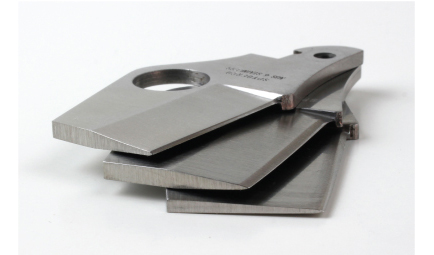
The performance of a knife as a cutting tool is determined by many factors. While the most obvious—blade steel and heat treatment—do have a profound impact on cutting performance, the grind of the blade is equally important. And when it comes to choosing a knife that is appropriate to your needs and style of knife use, understanding blade grinds and the edge geometry they provide is critically important. The grind of a blade is basically the shape of its cross-sectional profile—what you would see if you cut a blade in half and looked closely at the cut end. This profile is created by the grinding process that produces the primary blade bevels and is determined by shape of the grinding media and the mechanics of that process. In simple terms, there are three basic types of primary blade bevels: flat (a perfectly flat plane), concave (curving inward), or convex (curving outward). They can also extend the full width of the blade or only part of its width, leaving the spine of the blade full thickness for maximum strength. In most cases, the primary blade bevels intersect with a set of secondary bevels that form the blade’s actual cutting edge; however, some grinds—such as the Scandinavian or “Scandi” grind—the primary bevels actually intersect to form the cutting edge. This style of blade is often referred to as having a “zero ground” edge. Blade bevels are critically important to the cutting performance of a knife because they determine the amount of resistance a blade experiences while passing through a material. Think of a knife blade as a wedge. Thin wedges separate materials gradually and typically offer less resistance. Because they are thin, they are also weaker. Thick wedges split materials quickly, but meet greater resistance as they do. They also offer greater structural strength. Optimal blade geometry is therefore a matter of balancing the resistance experienced while cutting with the strength of the blade relative to the tasks being performed by that knife. Since most blades have secondary bevels to create the actual cutting edge, one other important—but often overlooked—aspect of blade geometry is the terminal thickness of the primary bevels. In other words, how thick is the blade where it transitions from the primary bevel to the secondary bevel of the actual cutting edge. While a thicker blade will offer greater strength, it also creates an abrupt transition from the cutting edge to the primary bevel, increasing resistance. Increased thickness at this point also requires that the secondary bevels of the cutting edge are wider and can shorten the useful life of the knife over repeated sharpening. The three most common blade grinds used by Spyderco are the following: Saber Grind: This is a partial flat grind. The upper half of the blade is left full thickness for strength, and the primary blade bevels are ground flat on the lower half. Secondary edge bevels create the actual cutting edge. This style of grind offers maximum strength, but the trade-off is increased resistance during cutting. Saber grinds also cannot be sharpened as many times as other blade geometries. Full-Flat Grind: As its name implies, a full-flat grind features flat primary bevels that extend the full width of the blade. Again, secondary edge bevels create the actual cutting edge. The wide, flat bevels of this grind greatly reduce friction and allow full-flat-ground knives to excel at slicing chores. That’s why this grind is typically used on kitchen knives. Full-flat-ground blades are also lighter than saber-ground ones, but do not offer the same strength. Hollow Grind: A hollow grind is produced by using round grinding wheels to create concave blade bevels. Spyderco knives typically use a partial hollow grind, which leaves the upper half of the blade at full thickness for strength. While seemingly similar to a saber grind, the concave shape of a hollow grind reduces the terminal thickness of the primary bevels, easing the transition from the cutting edge to the bevel and reducing friction. Hollow-ground blades also have a longer sharpening lifespan than saber-ground blades. We will examine other blade geometries in future issues of the Spyderco Byte, but hopefully this information will give you a deeper understanding of blade grinds and the influence they have on knife performance. |

|
|

|
KIT CARSON Harold Joseph “Kit” Carson was an acclaimed knifemaker for more than thirty-five years and is held in high regard for both his custom creations and his innovative collaborations with production knife companies. News of his passing is reverberating through the knife industry this September as the cutlery community loses one of the “greats”. Kit has been a leader in design and innovation and is the acknowledged inventor of the Kit Carson Flipper opening mechanism. The Kit Carson Flipper is a pivotal design in the genre of assisted opening knife blades. The flipper is a protrusion extending from the bottom side of the knife blade that when pushed with the index finger, rotates the blade into the open position. Mr. Carson was a member of the prestigious Blade Magazine Cutlery Hall of Fame and the Knifemakers Guild and retired from service as a professional soldier, Sergeant Major, from the U.S. Army. His life spent outdoors in the Georgia Mountains, and in the field as a member of our military, influenced his knife crafting philosophy, leading him to focus his fixed blade and folder designs around form and functional application. On behalf of the Spyderco Crew and all in the knife industry, he will be missed and continue to be appreciated as a ground-breaking innovator in our business. http://www.kitcarsonknives.com/index.html 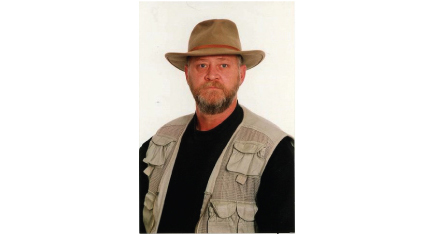
|

|
|

|

Spyderco Factory Outlet Store Sale Event Saturday, November 22, 2014 8:00am-5:00pm This anticipated event is your opportunity to purchase Spyderco factory seconds, closeout items, and other select products at incredible discounts.
Spyderco is currently under construction and parking is limited, please plan accordingly and thank you for your patience. |

|
|

|
SWICK 4 AVAILABLE EXCLUSIVELY THROUGH SPYDERCO FACTORY OUTLET 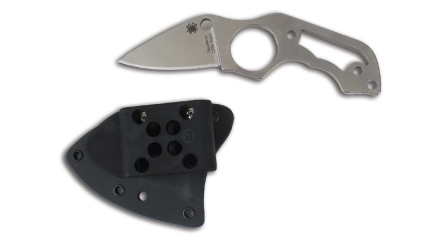
The original Swick™ was developed for fast deployment, lightweight carry, and an exceptionally secure ergonomic grip. The result of Spyderco’s relentless Constant Quality Improvement (C.Q.I.) process, the Swick 4 is a highly refined expression of the original concept that offers even greater versatility and strength. Like its predecessors, the Swick 4 was designed by Sal Glesser and features a large index-finger hole—a feature pioneered by custom knifemaker Fred Perrin. Placing your index finger through the hole locks the knife securely into your grip and greatly reduces the possibility of it being dropped or dislodged during use. It also allows you to keep the knife in your hand while freeing your fingers to perform other tasks. The Swick 4’s enhanced finger-hole design is larger and is complemented by jimping (textured grooves) on the thumb ramp to further enhance grip control during use. The Swick 4 is precision machined from a solid piece of high-performance CPM® S30V® powdered metallurgy stainless steel. It features a full-flat-ground leaf-shaped blade for superior edge geometry and a skeletonized tang to minimize weight without sacrificing strength. The ergonomic handle is slim and perfectly functional in its bare state, but also features pin holes for easy attachment of handle scales or paracord wrap. Every Swick 4 comes complete with a custom-molded Boltaron™ sheath and a G-Clip attachment. The versatile G-Clip is angle adjustable and can be mounted to either side of the sheath, providing a full range of belt or inside-the-waistband carry options. MSRP $69.95 |

|
|

|
REMEMBERING 9/11 The Spyderco Factory Outlet store maintains a permanent display of steel girders from Tower One of New York City's World Trade Center. Throughout the year, but especially this month of September, people pilgrimage to the store and take a moment to visit the exhibit as a reminder of the lives lost in the tragic events of September 11, 2001. Spyderco hosts this memorial as an enduring tribute to their memories and a symbol of our resolve to Never Forget. We invite you to come into SFO, say hello and take it in. 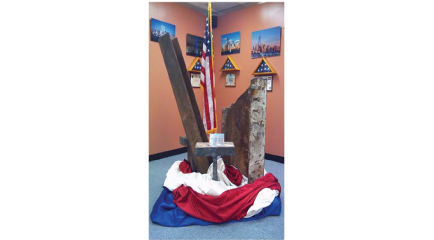
|

|
|

|
EVER HEARD OF THE TOUGH MUDDER? SPYDERCO FINISHES THE RACE The Tough Mudder is a 10-12 mile (18-20 km) foot race obstacle course designed to test all-around strength, teamwork and mental grit. Tough Mudder races are held year round and worldwide with many hosted in different U.S. cities. Considered one of the most difficult obstacle course races today, it challenges even the most fit people but also represents a set of values bringing together both individuals and teams using camaraderie, group effort and (although it may not look like it) a whole lotta fun. Team Spyderco was up for the challenge and on September 6, 2014 conquered the Mudder course on Snowmass/Aspen Mountain including water, mud, and electric obstacles with names like Leap of Faith, Ladder to Hell, Balls to the Wall, Electric Eel and Walk the Plank. Tough Mudder races support Wounded Warrior Project® (WWP) and Mudders have raised over $6 million for WWP, whose mission is to honor and empower Wounded Warriors. Congrats Team Spyderco.
|

|
   
|
   
|

|
